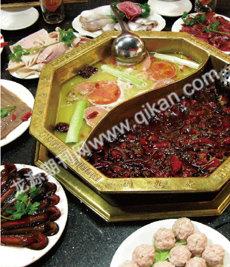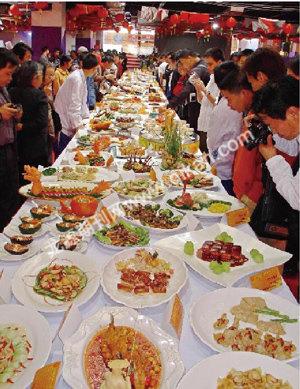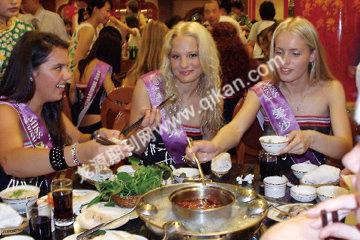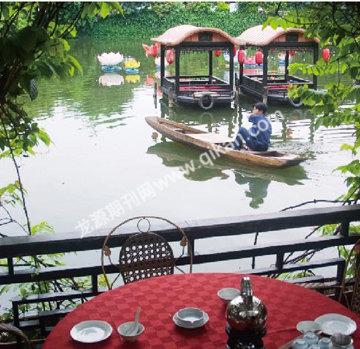Gastronomic Tour
By staff reporter ZHANG XUEYING

CHINESE cuisine is renowned for its eight major distinctive styles: the cuisines of Shandong, Zhejiang and Jiangsu in eastern China; Anhui and Hunan in central China; Sichuan in western China; and Fujian and Cantonese cooking in southern China. Each style has anything from dozens to hundreds of delicacies developed over many centuries.
Differences in climate, environment and ingredients mean each city makes distinctive dishes based on a traditional menu, ranging from West Lake fish in vinegar gravy and fried shrimps with Longjing tea in Zhejiang, to wontons and Chongqing hot pot in Sichuan. Moreover, each family develops special recipes according to individual tastes. It is no exaggeration to describe the variety of Chinese food as almost infinite.
In recent years, thanks to a more stable and affluent lifestyle, peoples desire to explore Chinas various cuisines has grown, and there are now more than 4 million restaurants across the nation. Cooks are devoted to the study of culinary art, and search through the old to bring forth the new.
However, behind the prosperous Chinese food industry, gastronomists worry that the distinctive characteristics of various cuisines are being obscured and regional differences are slowly fading.
Delicious Cantonese Cuisine
Cantonese and Sichuanese cuisines are the only two styles that still retain their authentic tastes. To have real Cantonese cuisine, you must go to Guangdong or Hong Kong.
Located in south China and facing the South China Sea, the subtropical climate makes Guangdong ample in rainfall, evergreen in seasons and abundant in food products. The freshness of ingredients in Cantonese cooking is an absolute priority.

If you want to eat like the Cantonese, a Guangdong-style breakfast is a must. In recent years it has expanded to more than 1,000 varieties, though each restaurant commonly provides a choice of not more than 20 dishes. These usually include shrimp dumplings, chicken feet, barbequed pork buns, starch sausages, and various forms of congee and noodles.
Shrimp dumplings and chicken feet are particularly noteworthy specialties that are not only popular, but are considered indicative of a restaurants overall quality.
According to historical information, shrimp dumplings originated in the 1920s in Wufeng Village on the outskirts of Guangzhou. The area was rich in seafood products, so the boss of a local family teahouse made use of these readily available ingredients. He took fresh shrimp meat as stuffing and high-quality glutinous rice flour as a wrapper, and made delicious shrimp dumplings. The dish was so popular he couldnt meet demand. Over time shrimp dumplings have become one of the most representative snacks in Guangzhou teahouses.
While fresh shrimp meat is undoubtedly the major selling point of this dish, the quality of the wrapper should not be overlooked. Unlike dumplings in northern China that use flour, the outside of shrimp dumplings are made with the material obtained from scouring off wheat gluten. Consequently the wrapper is white and fine, and slightly transparent after steaming. If the wrapper is thin enough, the pink stuffing will be partly visible, making ones mouth water.

Although shrimp dumplings are the basic refreshment for every Guangdong teahouse, their making demands quite challenging workmanship. First, the materials must be of superior quality. Authentic stuffing consists of both raw and cooked shrimp meat, fat and shredded bamboo shoots. Processed flour with lard, salt and water also feature in the mix. As mentioned above, the wrapper should be thin and transparent, and the finished dumpling wonderfully juicy in texture.
To please hungry diners, todays cooks stress the size and integrity of the shrimps, but tend to ignore the other ingredients. To suit modern healthy diets, the indispensable lard has been greatly reduced, or in some cases is no longer added. As a result, the texture often becomes dry and dull.
The shrimp dumplings in Guangzhous Flory City Restaurant are generally recommended by connoisseurs. Although the price of RMB 30 for six dumplings, or RMB 18 for three, is a tad expensive compared to average prices in Guangzhou, the dumplings are of superior quality.
Much like Guangdongs dumplings, the texture of chicken feet is unique. Theres not much more to them than bone and marrow, and people generally dont regard the feet as a dainty dish.
Throughout its 2,000-year history, Guangdong food has been based on maintaining the taste of the primary ingredients, so supplementary materials that cover the central flavor are usually avoided. Chicken feet are an exception. They are usually deep fried and pickled with fermented soybeans, oyster sauce, soy sauce and other strong spices before being steamed. The resulting soft texture and dense flavor means people cant help salivating.
Fine materials, excellent skills and fresh tastes are the cornerstones of Cantonese cuisine. Since there are more than 4,000 famous dishes from this southern province, its hard to really give a summary of the wealth of delicacies on offer.

Spicy Sichuan Cuisine
“Spicy” is usually the first impression diners have of Sichuan cuisine, but actually authentic Sichuan food should be salty. Chongqing dishes still maintain the areas original salty taste, while Chengdu cuisine has evolved over hundreds of years into todays well known spicy fare.
Located in a basin in west China, Sichuan is mild and moist in climate, with little difference between day and night temperatures. Ancient people in the area had to pickle food with salt to preserve it. Spice was then added to increase its delicacy.
Another explanation for the local foods spicy nature is that pungent seasoning helped cover strong smells. Beef and mutton have long been a major part of Chinese peoples diets, so strong seasoning was commonly used to remove the odors produced by these meats. With the evolution of agriculture and poultry breeding, the importance of covering unpleasant aromas has faded. Sichuans damp climate remains an issue however. Gastronomists believe eating chili can help drive away the “chillness and moisture” that characterizes the local air by accelerating blood circulation and warding off damp vapors. Spice also stimulates ones system, making it an “effective medicine to cure depression” in a province where winters are often clammy and foggy.

In recent years, urbanites across China have become addicted to the “excitement” of chili, and Sichuan-style cooking has become popular everywhere. As a result, Sichuan restaurants are now common in most Chinese cities and towns.
Chengdu cuisine is the center of Sichuan cooking, and has become a synonym for luxury. This is evident not only in the sumptuous decoration of local restaurants, but also in the citys food, which has become known as “New Sichuan cuisine.” The best area to sample the latest in Chengdu cooking is Xiyanxian. The Chengdu hot pot on Qintai Road is also considered very authentic, while the Chuandonglaojia Restaurant near Laochengguan Road is well known for its more traditional Sichuan fare.
Twice-cooked pork is a must-eat home-style Chengdu dish that embodies the essence of Sichuan cuisine. The famous dish derives from ancient offerings. Pork placed on altars as an offering was usually lightly cooked, and after the ceremony it was unwise to stew the cold meat again. Instead, people would quick-fry it, stirring the meat with garlic shoots. Hence the name twice-cooked pork.
To make genuine twice-cooked pork you must use rump meat, green garlic shoots, broad beans from Pixian County, fermented soybeans and 10 other supplementary materials. The size of the pork slices is also important. It should be three cm long and 0.3 cm wide. The meat should be stewed until it is medium rare. It is also important to get the temperature of the oil and seasonings just right during the stir-frying to achieve the perfect color, aroma and taste.
Elegant Zhejiang and Jiangsu Cuisine
Hangzhou and Suzhou are the centers of Zhejiang and Jiangsu cuisines respectively. Chefs in both places pay close attention to freshness and tenderness. The key difference between the two styles is that Zhejiang cuisine involves more vinegary tastes, while Jiangsu cuisine is sweet.
The two adjoining provinces have formed Chinas most prosperous and richest area since ancient times, and have long attracted wealthy merchants and scholars. The climate is mild and humid, and numerous rivers ensure there are plentiful ingredients available.
Songhelou Restaurant on Suzhous Shantang Street is the best place to enjoy Jiangsu cuisine, and Louwailou Restaurant near Hangzhous West Lake is best for Zhejiang cuisine. Both Zhejiang and Jiangsu cuisines place great emphasis on offering diners a pleasing environment in which to eat, but elegant scenes are hard to find these days in the busy urban districts of Hangzhou. Even the time-honored Songhelou Restaurant is now surrounded by the bustle and noise of the citys busy downtown area. In contrast, Louwailou Restaurant is surrounded by a pleasing environment of hills and lakes.
Gastronomists also recommend another restaurant on Longjing Road, called Yiyuan Longjing Manor. This picturesque private manor is surrounded by a concentrated dose of Hangzhou scenery. There is no menu and diners need a reservation. All food materials are purchased directly from farmers, and dishes are cooked using firewood and without additives, gourmet powders or sugar. Meals are meticulously prepared, with the pork braised in brown sauce for three days and the duck stewed for a whole afternoon. Sixty staff members labor to provide exquisite meals for just 12 tables a day.
Among Chinas eight famous styles of cooking, “classical” Shandong cuisine has now melted into the new school of Beijing flavors. Anhui and Hunan cuisines have similarly blended with Sichuan dishes and lost their distinctive color.

